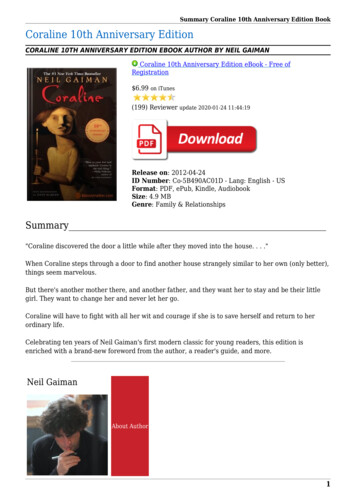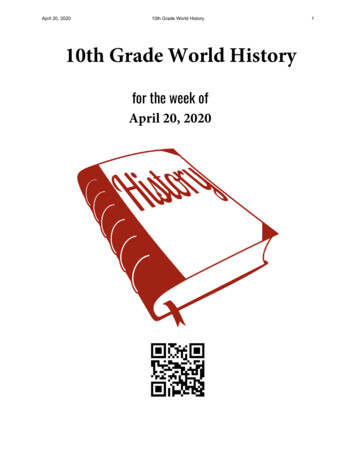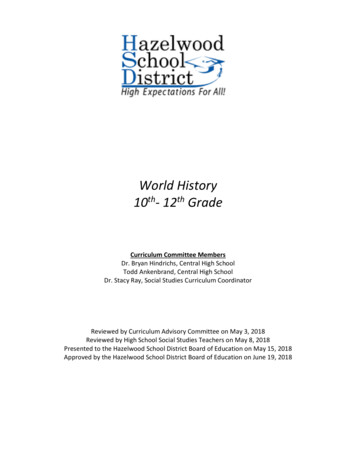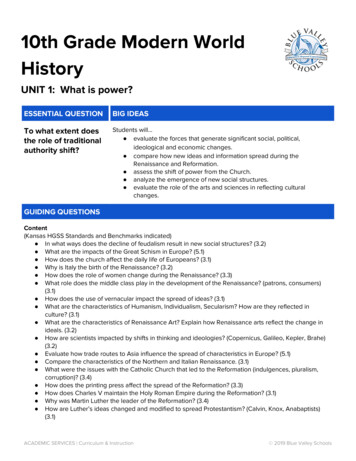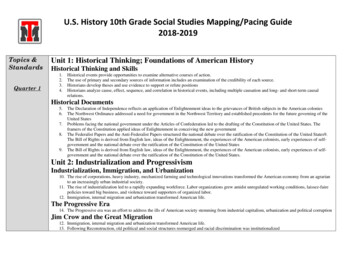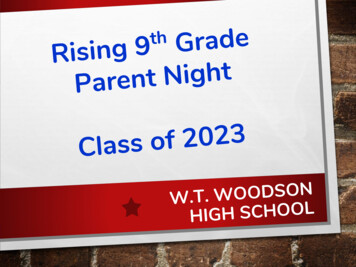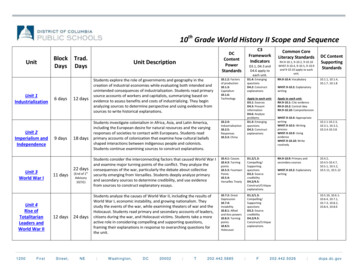
Transcription
10th Grade World History II Scope and SequenceUnitUnit 1IndustrializationUnit 2Imperialism andIndependenceUnit 3World War IUnit 4Rise ofTotalitarianLeaders andWorld War II1200F irstBlockDays6 days9 daysTrad.Days12 days18 days22 days11 days(End of 1stAdvisory10/31)12 days 24 daysSt re et ,NEUnit DescriptionStudents explore the role of governments and geography in thecreation of industrial economies while evaluating both intended andunintended consequences of industrialization. Students read primarysource accounts of workers and capitalists, summarizing based onevidence to assess benefits and costs of industrializing. They beginanalyzing sources to determine perspective and using evidence fromsources to write historical explanations.10.1.2: Factorsof ts investigate colonialism in Africa, Asia, and Latin America,including the European desire for natural resources and the varyingresponses of societies to contact with Europeans. Students readprimary accounts of colonization that examine how cultural beliefsshaped interactions between indigenous people and colonists.Students continue examining sources to construct ses10.3.3: ChinaStudents consider the interconnecting factors that caused World War Iand examine major turning points of the conflict. They analyze theconsequences of the war, particularly the debate about collectivesecurity emerging from Versailles. Students deeply analyze primaryand secondary sources to determine credibility, and use evidencefrom sources to construct explanatory essays.Students analyze the causes of World War II, including the results ofWorld War I, economic instability, and growing nationalism. Theystudy the events of the war, while examining theaters of war and theHolocaust. Students read primary and secondary accounts of leaders,citizens during the war, and Holocaust victims. Students take a moreactive role in considering compelling and supporting questions,framing their explanations in response to overarching questions forthe unit. W ashi ngt ards TD3.1, D4.3 andD4.6 apply toeach unit.Common CoreLiteracy StandardsRH.9-10.1, 9-10.2, 9-10.10WHST.9-10.4, 9-10.5, 9-10.9and 9-10.10 apply to eachunit.D1.4: EmergingquestionsD4.2: ConstructexplanationsRH.9-10.4: VocabularyApply to each unit:D3.1: SourcesD4.3: PresentinformationD4.6: AnalyzeproblemsD1.4: EmergingquestionsD4.2: ConstructexplanationsApply to each unit:RH.9-10.1: Cite evidenceRH.9-10.2: Central ideaRH.9-10.10: Comprehension10.4.1: Causes10.4.3: Turningpoints10.5.3: FourteenPoints10.5.4:Versailles TreatyD1.2/1.3:Compelling/SupportingquestionsD3.2: ationsRH.9-10.9: Primary andsecondary sources10.7.2: GreatDepression10.7.4:Instability10.8.1: Alliedand Axis powers10.8.3: upportingquestionsD3.2: ations202. 442.5885 FDC ContentSupportingStandards10.1.1, 10.1.4,10.1.7, 10.1.8WHST.9-10.2: ExplanatorywritingWHST.9-10.4: AppropriatewritingWHST.9-10.5: WritingprocessWHST.9-10.9: UsingevidenceWHST.9-10.10: WriteroutinelyWHST.9-10.2: Explanatorywriting202.442. 502610.2.1-10.2.3,10.3.1, 10.3.2,10.3.4-10.3.810.4.2,10.4.5-10.4.7,10.5.1, 10.5.2,10.5.11, 10.5.1210.5.10, 10.6.110.6.4, 10.7.1,10.7.3, 10.8.2,10.8.4, 10.8.6 dcps .dc. gov
10th Grade World History II Scope and SequenceUnitBlockDaysTrad.Days11 daysUnit 5Cold War andPost-war shiftsUnit 6Modern Africaand LatinAmericaUnit 7Post-War AsiaUnit 8ModernMiddle EastUnit 9Globalizationand the ModernWorld(End of 1stAdvisory10/31End of 3rdAdvisory4/3)22 days(End of 2ndAdvisory.1/23)10 days 20 days14 days7 days6 days(End of 3rdAdvisory4/3)12 days8 days(End of 2ndAdvisory1/23End of 4thAdvisory6/17)16 daysth(End of 4Advisory6/17)Unit DescriptionStudents consider the conflicting ideologies of the United States andthe Soviet Union (e.g. freedom vs. equality, capitalism vs. socialism,democracy vs. totalitarianism, individualism vs. collectivism) and howthe conflict played out internationally. They study the rise and fall ofthe Soviet Union, analyzing the relationship between government andthe socialist economy. Students debate historiographicalinterpretation using evidence to support their claims as they move toargumentative writing.Students analyze the lasting consequences of colonialism on thedevelopment of nations in Africa and Latin America, considering thefactors that led to pan-Africanism and the challenges in post-colonialstates. Students read complex texts and analyze textual structure todetermine meaning and critique arguments. Students writeargumentative essays, drawing textual evidence to support theirclaims.Students examine the impact of political ideology and religion on thedevelopment of Asian nations after World War II, with particular focuson the Communist revolution in China, the partitioning of India, oreconomic development in East and Southeast Asia. Students draw ondiverse types of sources for their historical analysis, assessinghistorical precedents for action in preparation for argument writing.Students consider the political, social, and economic spheres ofnations in the Middle East, including war in the region, Islamicfundamentalism, and oil-rich economies. Students read accountsfrom Arab and Israeli perspectives to understand the influence ofpoint of view. Students write increasingly sophisticated argumentessays, refining their claims through the revision process andbeginning to take action to apply what they have learned.Students investigate the influence of advanced communication on thecreation of an increasingly global society, tracing the impact ofinternational interactions on economics. Students read texts to tracethe development of argument through the author’s craft and applyadvanced strategies for argument development to their own writing.Students take informed action based on their arguments.District of Columbia Public Schools December .1, D4.3 andD4.6 apply toeach unit.Common CoreLiteracy StandardsRH.9-10.1, 9-10.2, 9-10.10WHST.9-10.4, 9-10.5, 9-10.9and 9-10.10 apply to eachunit.10.9.7:Econ/Militaryshifts10.10: Cold War10.13.1: SovietUnion 1: ConstructargumentsRH.9-10.3: Cause/effectRH.9-10.6: Point of view10.11.3: PanAfricanism10.11.11:Challenges10.14.2: H.9-10.5: StructureRH.9-10.8: Argument10.12.2:CommunistChina10.12.4:Partition ofIndia10.12.7:Southeast Asia10.12.9:Economic Rise10.15.1: PersianGulf nations10.15.2: Arab/Israeli conflict10.15.7: IslamicradicalismD1.5: Kinds ofsourcesD3.3: IdentifyevidenceD4.1/4.7: Constructarguments/ Assessoptions for actionD1.5: Kinds ofsourcesD3.4: Refine claimsD4.1/4.7/4.8:Constructarguments/ Assessoptions foraction/Take actionRH.9-10.7: Integratedifferent info (visuals, text)10.14.6:Economic 10.16.5:InternetD1.1: EnduringissuesD3.2: Sourcecredibility andvaluationD4.1/4.8: Constructarguments/TakeactionRH.9-10.8: ArgumentWHST.9-10.1: ArgumentativewritingWHST.9-10.7: ResearchWHST.9-10.8: SourcesWHST.9-10.1: ArgumentativewritingWHST.9-10.7: ResearchWHST.9-10.8: SourcesDC ContentSupportingStandards10.9.1, 1, 10.11.2,10.11.4-10.11.6,10.11.8, 10.11.9,10.11.12, 10.14.1,10.14.4, 10.14.5,10.14.910.12.1, 10,12.3,10.12.5, 10.12.8,10.12.1010.15.3-10.15.6,10.15.8, 10.15.9WHST.9-10.1: ArgumentativewritingWHST.9-10.7: ResearchWHST.9-10.8: SourcesWHST.9-10.6: Technology10.14.8, 10.16.1,10.16.4, 10.16.6,10.16.7Page 2 of 15
10th Grade World History II Scope and SequenceUnitInformationDC Content PowerStandardsUnit 1Industrialization10.1.2: Explain theconnections among naturalresources, entrepreneurship,labor, and capital in anindustrial economy.Block: 6 daysTraditional: 12 daysStudents explore the roleof governments andgeography in the creationof industrial economieswhile evaluating bothintended and unintendedconsequences ofindustrialization. Studentsread primary sourceaccounts of workers andcapitalists, summarizingbased on evidence toassess benefits and costsof industrializing. Theybegin analyzing sources todetermine perspective andusing evidence fromsources to write historicalexplanations.10.1.3: Analyze theemergence of capitalism as adominant economic patternand the responses to it,including Utopianism, SocialDemocracy, Socialism, andCommunism (e.g., AdamSmith, Robert Owen, and KarlMarx).10.1.6: Explain how scientificand technological changesand new forms of energybrought about massive social,economic, and culturalchange (e.g., the inventionsand discoveries of JamesWatt, Eli Whitney, EllijahMcCoy, Henry Bessemer,Louis Pasteur, and ThomasEdison).District of Columbia Public Schools December 2014C3 FrameworkIndicatorsD3.1, D4.3 and D4.6 apply toeach unit.D1.4: Explain howsupporting questionscontribute to an inquiry andhow, through engagingsource work, newcompelling and supportingquestions emerge.D4.2: Construct explanationsusing sound reasoning,correct sequence (liner ornon-linear), examples, anddetails with significant andpertinent information anddata, while acknowledgingthe strengths andweaknesses of theexplanation given itspurpose (e.g., cause andeffect, chronological,procedural, technical).Common Core Literacy StandardsRH.9-10.1, 9-10.2, 9-10.10WHST.9-10.4, 9-10.5, 9-10.9 and 9-10.10 apply toeach unit.RH.9-10.4: Determine the meaning of wordsand phrases as they are used in a text,including vocabulary describing political,social, or economic aspects of history/socialscience.WHST.9-10.2: Write informative/explanatorytexts, including the narration of historicalevents, scientific procedures/ experiments, ortechnical processes.(a) Introduce a topic and organize ideas,concepts, and information to make importantconnections and distinctions; includeformatting (e.g., headings), graphics (e.g.,figures, tables), and multimedia when usefulto aiding comprehension.(b) Develop the topic with well-chosen,relevant, and sufficient facts, extendeddefinitions, concrete details, quotations, orother information and examples appropriateto the audience's knowledge of the topic.(c) Use varied transitions and sentencestructures to link the major sections of thetext, create cohesion, and clarify therelationships among ideas and concepts.(d) Use precise language and domain-specificvocabulary to manage the complexity of thetopic and convey a style appropriate to thediscipline and context as well as to theexpertise of likely readers.(e) Establish and maintain a formal style andobjective tone while attending to the normsand conventions of the discipline in whichthey are writing.(f) Provide a concluding statement or sectionthat follows from and supports theinformation or explanation presented (e.g.,articulating implications or the significance ofthe topic).DC Content Supporting Standards10.1.1: Describe the growth of population, rural tourban migration, and growth of cities.10.1.4: Describe the emergence of Romanticism inart and literature (e.g., the poetry of William Blakeand William Wordsworth), social criticism (e.g., thenovels of Charles Dickens), and the move away fromClassicism in Europe.10.1.7: Trace the evolution of work and labor,including the demise of the slave trade, problemscaused by harsh working conditions, and the effectsof immigration, mining and manufacturing, divisionof labor, and the union movement.10.1.8: Explain the vast increases in productivityand wealth, growth of a middle class, and generalrise in the standard of living and life span.Page 3 of 15
10th Grade World History II Scope and SequenceUnitInformationDC Content PowerStandardsUnit 1Industrialization(continued)(see previous page)C3 FrameworkIndicatorsD3.1, D4.3 and D4.6 apply toeach unit.RH.9-10.1, 9-10.2, 9-10.10WHST.9-10.4, 9-10.5, 9-10.9 and 9-10.10 apply toeach unit.Apply to each unit:Apply to each unit:D3.1: Gather relevantinformation from multiplesources representing a widerange of views while usingthe origin, authority,structure, context, andcorroborative value of thesources to guide theselection.RH.9-10.1: Cite specific textual evidence tosupport analysis of primary and secondarysources, attending to such features as thedate and origin of the information.DC Content Supporting Standards(see previous page)D4.3: Present adaptations ofarguments and explanationsthat feature evocative ideasand topics to reach a rangeof audiences and venuesoutside the classroom usingprint and oral technologies(e.g., posters, essays, letters,debates, speeches, reports,and maps) and digitaltechnologies (e.g., Internet,social media, and digitaldocumentary).D4.6: Use disciplinary andinterdisciplinary lenses tounderstand thecharacteristics and causes oflocal, regional, and globalproblems; instances of suchproblems in multiplecontexts; and challenges andopportunities faced by thosetrying to address theseproblems over time andplace.District of Columbia Public Schools December 2014Common Core Literacy StandardsRH.9-10.2: Determine the central ideas orinformation of a primary or secondary source;provide an accurate summary of how keyevents or ideas develop over the course ofthe text.RH.9-10.10: By the end of grade 10, read andcomprehend history/social studies texts in thegrades 9–10 text complexity bandindependently and proficiently.WHST.9-10.4: Produce clear and coherentwriting in which the development,organization, and style are appropriate totask, purpose, and audience.WHST.9-10.5: Develop and strengthen writingas needed by planning, revising, editing,rewriting, or trying a new approach, focusingon addressing what is most significant for aspecific purpose and audience.WHST.9-10.9: Draw evidence frominformational texts to support analysis,reflection, and research.WHST.9-10.10: Write routinely over extendedtime frames (time for reflection and revision)and shorter time frames (a single sitting or aday or two) for a range of discipline-specifictasks, purposes, and audiences.Page 4 of 15
10th Grade World History II Scope and SequenceUnitInformationDC Content PowerStandardsUnit 2Imperialism andIndependence10.2.4: Describe the rise ofindustrial economies and theirlink to imperialism andcolonialism (e.g., the role playedby national security and strategicadvantage; moral issues raised bythe search for nationalhegemony, Social Darwinism, andthe missionary impulse; andmaterial issues, such as land,resources, and technology).Block: 9 daysTraditional: 18 daysStudents investigatecolonialism in Africa, Asia,and Latin America,including the Europeandesire for naturalresources and the varyingresponses of societies tocontact with Europeans.Students read primaryaccounts of colonizationthat examine how culturalbeliefs shaped interactionsbetween indigenouspeople and colonists.Students continueexamining sources toconstruct explanations.10.2.5: Explain the variedimmediate and long-termresponses by the people undercolonial rule.10.3.3: Explain the growingWestern encroachment onChina’s sovereignty, the BoxerRebellion, and Sun Yat-Sen andthe 1911 Republican Revolution.C3 FrameworkIndicatorsD3.1, D4.3 and D4.6 apply toeach unit.D1.4: Explain how supportingquestions contribute to aninquiry and how, throughengaging source work, newcompelling and supportingquestions emerge.D4.2: Construct explanationsusing sound reasoning, correctsequence (liner or non-linear),examples, and details withsignificant and pertinentinformation and data, whileacknowledging the strengthsand weaknesses of theexplanation given its purpose(e.g., cause and effect,chronological, procedural,technical).Common Core Literacy StandardsRH.9-10.1, 9-10.2, 9-10.10WHST.9-10.4, 9-10.5, 9-10.9 and 9-10.10 apply toeach unit.RH.9-10.4: Determine the meaning of words andphrases as they are used in a text, includingvocabulary describing political, social, or economicaspects of history/social science.WHST.9-10.2: Write informative/explanatory texts,including the narration of historical events,scientific procedures/ experiments, or technicalprocesses.(a) Introduce a topic and organize ideas, concepts,and information to make important connectionsand distinctions; include formatting (e.g., headings),graphics (e.g., figures, tables), and multimediawhen useful to aiding comprehension.(b) Develop the topic with well-chosen, relevant,and sufficient facts, extended definitions, concretedetails, quotations, or other information andexamples appropriate to the audience's knowledgeof the topic.(c) Use varied transitions and sentence structuresto link the major sections of the text, createcohesion, and clarify the relationships among ideasand concepts.(d) Use precise language and domain-specificvocabulary to manage the complexity of the topicand convey a style appropriate to the discipline andcontext as well as to the expertise of likely readers.(e) Establish and maintain a formal style andobjective tone while attending to the norms andconventions of the discipline in which they arewriting.(f) Provide a concluding statement or section thatfollows from and supports the information orexplanation presented (e.g., articulatingimplications or the significance of the topic).DC Content Supporting Standards10.2.1: Explain the role of religious wars in Europe and thesearch for natural resources and new markets as preludeto the Berlin Conference.10.2.2: Describe the Berlin Conference and the rise ofmodern colonialism in the 19th century.10.2.3: Describe the locations of colonies established bysuch nations as England, France, Germany, Italy, Japan, theNetherlands, Russia, Spain, Portugal, and the UnitedStates.10.3.1: Analyze Africa’s interaction with imperialism (ZuluWars, Mahdist Movement, Ashanti Wars, and Africanresistance and/or collaboration throughout the continent).10.3.2: Explain the importance of Ethiopia’s Battle ofAdowa and the defeat of Italian invaders to remainindependent.10.3.4: Explain the transfer in 1858 of government toGreat Britain on the Indian Subcontinent following theSepoy Rebellion.10.3.5: Describe American imperialism of the Philippinesand the fight for freedom in the Philippine-American Warled by Emilio Aquinaldo.10.3.6: Explain the military interventions of the UnitedStates in Central America and the Caribbean, thesubsequent occupation of some of the territories, andlocal resistance to growing U.S. influence, as evidenced inCuba, Puerto Rico, Haiti, the Dominican Republic, Panama,and Nicaragua.10.3.7 Explain the desire for land reform and democraticparticipation that resulted in the movements led byEmiliano Zapata, Francisco Madero, Pancho Villa, andVenustiano Carranza in Mexico; César Augusto Sandino inNicaragua; Jacobo Arbenz in Guatemala; and FarabundoMartí in El Salvador.10.3.8 Explain the emergence of populist and democraticleaders in Latin America, such as Juan Perón, GetulioVargas, José Figueres, Luis Muñoz Marín, and RómuloBetancourt.District of Columbia Public Schools December 2014Page 5 of 15
10th Grade World History II Scope and SequenceUnitInformationDC Content PowerStandardsUnit 3World War I10.4.1: Analyze the argumentsfor entering into war presentedby leaders from all sides of theGreat War.Block: 11 daysTraditional: 22 daysst(End of 1 Advisory 10/31)Students consider theinterconnecting factorsthat caused World War Iand examine major turningpoints of the conflict. Theyanalyze the consequencesof the war, particularly thedebate about collectivesecurity emerging fromVersailles. Students deeplyanalyze primary andsecondary sources todetermine credibility, anduse evidence from sourcesto construct explanatoryessays.10.4.3: Identify and explain theprincipal theaters of battle,major turning points, and theimportance of geographicfactors in military decisions andoutcomes (e.g., topography,waterways, distance, andclimate).10.5.3: Analyze the aims andnegotiating roles of worldleaders, including WoodrowWilson’s Fourteen Points, andthe causes and effects of theUnited States’ rejection of theLeague of Nations on worldpolitics.10.5.4: Describe the conflictingaims and aspirations of theconferees at Versailles and theVersailles treaty’s economicand moral effects on Germany.C3 FrameworkIndicatorsD3.1, D4.3 and D4.6 apply toeach unit.D1.2: Explain points ofagreement and disagreementexperts have aboutinterpretations andapplications of disciplinaryconcepts and ideas associatedwith a compelling question.D1.3: Explain points ofagreement and disagreementexperts have aboutinterpretations andapplications of disciplinaryconcepts and ideas associatedwith a supporting question.D3.2: Evaluate the credibilityof a source by examining howexperts value the source.D4.2: Construct explanationsusing sound reasoning, correctsequence (liner or non-linear),examples, and details withsignificant and pertinentinformation and data, whileacknowledging the strengthsand weaknesses of theexplanation given its purpose(e.g., cause and effect,chronological, procedural,technical).D4.5: Critique the use ofreasoning, sequencing, andsupporting details ofexplanations.District of Columbia Public Schools December 2014Common Core Literacy StandardsRH.9-10.1, 9-10.2, 9-10.10WHST.9-10.4, 9-10.5, 9-10.9 and 9-10.10 apply toeach unit.RH.9-10.9: Compare and contrast treatments ofthe same topic in several primary and secondarysources.WHST.9-10.2: Write informative/explanatorytexts, including the narration of historicalevents, scientific procedures/ experiments, ortechnical processes.(a) Introduce a topic and organize ideas,concepts, and information to make importantconnections and distinctions; include formatting(e.g., headings), graphics (e.g., figures, tables),and multimedia when useful to aidingcomprehension.(b) Develop the topic with well-chosen, relevant,and sufficient facts, extended definitions,concrete details, quotations, or otherinformation and examples appropriate to theaudience's knowledge of the topic.(c) Use varied transitions and sentencestructures to link the major sections of the text,create cohesion, and clarify the relationshipsamong ideas and concepts.(d) Use precise language and domain-specificvocabulary to manage the complexity of thetopic and convey a style appropriate to thediscipline and context as well as to the expertiseof likely readers.(e) Establish and maintain a formal style andobjective tone while attending to the norms andconventions of the discipline in which they arewriting.(f) Provide a concluding statement or sectionthat follows from and supports the informationor explanation presented (e.g., articulatingimplications or the significance of the topic).DC Content Supporting Standards10.4.2: Outline the role of political and economicrivalries, ethnic and ideological conflicts, domesticdiscontent, disorder, propaganda, and nationalism inmobilizing the civilian population in support of “totalwar.”10.4.5: Explain how the Russian Revolution and theentry of the United States affected the course andoutcome of the war.10.4.6: Describe human rights violations and genocide,including the Armenian genocide in Turkey.10.4.7: Explain the nature of the war and its humancosts (military and civilian) on all sides of the conflict,including unprecedented loss of life from prolongedtrench warfare.10.5.1: Describe advances in tank and aerial warfare,the belief that the “Great War” would end war, anddisarmament movements.10.5.2: Describe the effects of the war and resultingpeace treaties on population movement, theinternational economy, and shifts in the geographicand political borders of Europe and the Middle East.10.5.11: Analyze the objectives and achievements ofwomen’s political movements in the context of WorldWar I and its aftermath.10.5.12: Explain the influence of World War I onliterature, art, and intellectual life (e.g., Pablo Picasso,the Jazz Era music of the Harlem Hellfighters 369thRegiment Band and James Reese Europe; the “lostgeneration” of Gertrude Stein and Ernest Hemingway).Page 6 of 15
10th Grade World History II Scope and SequenceC3 FrameworkIndicatorsUnitInformationDC Content PowerStandardsUnit 4Rise of TotalitarianLeaders andWorld War II10.7.2: Describe the collapse ofinternational economies in 1929that led to the Great Depression,including the relationships thathad been forged between theU.S. and European economiesafter World War I.D3.1, D4.3 and D4.6 apply toeach unit.D1.2: Explain points ofagreement and disagreementexperts have aboutinterpretations and applicationsof disciplinary concepts andideas associated with acompelling question.10.7.4: Describe how economicinstability led to politicalinstability in many parts of theworld and helped to give rise todictatorial regimes such as AdolfHitler’s in Germany and themilitary’s in Japan.D1.3: Explain points ofagreement and disagreementexperts have aboutinterpretations and applicationsof disciplinary concepts andideas associated with asupporting question.10.8.1: Compare the German,Italian, and Japanese drives forempire in the 1930s, includingthe 1937 Rape of Nanking, otheratrocities in China, Italianinvasion of Ethiopia, Germanmilitarism, and the Stalin-HitlerPact of 1939.D3.2: Evaluate the credibility ofa source by examining howexperts value the source.Block: 12 daysTraditional: 24 daysStudents analyze thecauses of World War II,including the results ofWorld War I, economicinstability, and growingnationalism. They studythe events of the war,while examining theatersof war and the Holocaust.Students read primary andsecondary accounts ofleaders, citizens during thewar, and Holocaustvictims. Students take amore active role inconsidering compellingand supporting questions,framing their explanationsin response to overarchingquestions for the unit.10.8.3: Identify and locate theAllied and Axis powers and themajor turning points of the war,the principal theaters of conflict,key strategic decisions, and theresulting war conferences andpolitical resolutions, withemphasis on the importance ofgeographic factors.10.8.5: Explain the background ofthe Holocaust (including its rootsin 19th century ideas about raceand nation); the dehumanizationof the Jews through law, attitude,and actions such as badging,ghettoization, and killingprocesses; and how the Nazipersecution of gypsies,homosexuals, and others whofailed to meet the Aryan ideal.District of Columbia Public Schools December 2014D4.2: Construct explanationsusing sound reasoning, correctsequence (liner or non-linear),examples, and details withsignificant and pertinentinformation and data, whileacknowledging the strengthsand weaknesses of theexplanation given its purpose(e.g., cause and effect,chronological, procedural,technical).D4.5: Critique the use ofreasoning, sequencing, andsupporting details ofexplanations.Common Core Literacy StandardsRH.9-10.1, 9-10.2, 9-10.10WHST.9-10.4, 9-10.5, 9-10.9 and 9-10.10 apply toeach unit.DC Content Supporting StandardsRH.9-10.9: Compare and contrast treatments ofthe same topic in several primary and secondarysources.10.5.10: Explain the widespread disillusionment withprewar institutions, authorities, and values that resulted ina void that was later filled by totalitarians.WHST.9-10.2: Write informative/explanatory texts,including the narration of historical events,scientific procedures/ experiments, or technicalprocesses.(a) Introduce a topic and organize ideas, concepts,and information to make important connectionsand distinctions; include formatting (e.g., headings),graphics (e.g., figures, tables), and multimediawhen useful to aiding comprehension.(b) Develop the topic with well-chosen, relevant,and sufficient facts, extended definitions, concretedetails, quotations, or other information andexamples appropriate to the audience's knowledgeof the topic.(c) Use varied transitions and sentence structuresto link the major sections of the text, createcohesion, and clarify the relationships among ideasand concepts.(d) Use precise language and domain-specificvocabulary to manage the complexity of the topicand convey a style appropriate to the discipline andcontext as well as to the expertise of likely readers.(e) Establish and maintain a formal style andobjective tone while attending to the norms andconventions of the discipline in which they arewriting.(f) Provide a concluding statement or section thatfollows from and supports the information orexplanation presented (e.g., articulatingimplications or the significance of the topic).10.6.1: Identify the causes and consequences of theBolshevik Revolution and civil war in Russia, includingLenin’s use of totalitarian means to seize and maintaincontrol (e.g., the Gulag).10.6.2: Trace Stalin’s rise to power in the Soviet Union andthe connection between economic policies, politicalpolicies, the absence of a free press, and systematicviolations of human rights (e.g., the Terror Famine inUkraine).10.6.3: Analyze the assumption of power by Adolf Hitler inGermany, the resulting acts of oppression and aggression,and the human costs of the totalitarian regime.10.6.4: Describe Mussolini’s rise to power in Italy and hiscreation of a fascist state through the use of state terrorand propaganda.10.7.1: Explain the impact of restrictive monetary andtrade policies.10.7.3: Describe issues of unemployment and inflation.10.8.2: Explain the role of appeasement, nonintervention(isolationism), and the domestic distractions in Europe andthe United States prior to the outbreak of World War II.10.8.4: Describe the political, diplomatic, and militaryleaders during the war (e.g., Winston Churchill, FranklinDelano Roosevelt, Emperor Hirohito, Adolf Hitler, BenitoMussolini, Joseph Stalin, Douglas MacArthur, and DwightEisenhower).10.8.6: Describe the human costs of the war, withparticular attention to the civilian and military losses inRussia, Germany, Br
10th Grade World History II Scope and Sequence Unit Block Days Trad. Days Unit Description DC Content Power Standards C3 Framework Indicators D3.1, D4.3 and D4.6 apply to each unit. Common Core Literacy Standards RH.9-10.1, 9-10.2, 9-10.10 WHST. 9-10.4, 10.5, 10.9 and 9-10.10 apply to
